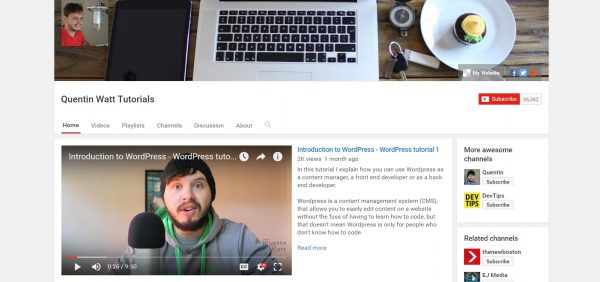“When I finished High School, I wanted to go to university. Unfortunately university is expensive and my father passed away when I was 12,” South African YouTuber, Quentin Watt shares with us. “My mom could not afford to send me to university and so I had to join the working world and take the first job I could find. Of course, I hated it.“
This is the start of Quentin Watt’s story. Fast forward four years and Watt has built up a YouTube channel with 65 000 subscribers and attracted some 6.8m views to his videos.
With the prospect of not being able to attend university leering over him Watt decided that he needed to do something to change the course his life had plotted out for him.
“I used the first money I earned to buy a laptop and internet, and this was when I discovered that YouTube is more than just a website to watch cute cat videos. User’s could set up channels, build followings, and amazingly the YouTube partner program had just opened up, and anyone in the world could now become a YouTube partner and monetise the content on their YouTube channel.”

Watt tells us that he seized the opportunity for three reasons. The first to see whether he could make money from YouTube. The second was to make his CV more attractive to prospective employers and finally, he simply wanted to give back to the community that had helped him.
“I needed some credentials to add to my CV. I thought, I don’t have a degree but I will have 5 000 subscribers. YouTube will help me make something of my life,” Watt tells us.
The YouTuber tells us that it took him 10 months to make a “whopping R1 000”, the amount that YouTube starts paying Partners from.
“After that, the money started rolling in monthly, and in bigger amounts too.”
Cracking the code
“How to” videos are a dime a dozen on YouTube. One simply needs to type “how to” and the phrase of choice into YouTube to see just how many of these videos populate the service.
This makes standing out from the crowd a difficult task, but one that Watt is getting to grips with.
“There aren’t many people who want to watch a 20 minute video and they can see how long a video is before clicking on it. People don’t want to waste their time, so keeping a video at a reasonable length will help earn you that click.”
Once you have the click, Watt explains, a creator needs to make the content contained within valuable to the viewer. “They need to have gained something out of your content within the first 3 minutes or they will click away,” Watt says.
The secret lives of South African YouTubers
YouTube has become overrun with creators and it may seem like a daunting task for a South African to compete with a behemoth like PewDiePie.
South Africans with their heart set on a YouTube Gold status (1 million or more subscribers) need a bit of patience according to Watt.
“It takes time to grow an audience on YouTube. If you do some research on any big YouTuber today, you’ll find plenty of evidence or stories about them making videos on YouTube for years before eventually blowing up and achieving success. Pewdiepie, and Ali-A are big examples of that. Casey Neistat is someone who is blowing up massively right now but he has been on YouTube for so many years already. In contrast, South African channels are very young and haven’t been around for very long,” says Watt.
One of the larger barriers holding back Africans from YouTube fame and fortune is sadly, the internet.
“Internet companies are holding us back. Our internet is super expensive in comparison to the rest of the world, and super slow especially on the upload. Having terrible upload speeds means it takes your average 4mbps ADSL user (who really only get 500kbps of their line dedicated to upload speed), about 7 hours to upload an HD video. If you’re lucky enough, and rich enough to have access to Fibre, the same job can be done in 5 to 15 minutes, but the price of Fibre over here compared to the UK is insane.
Hit like and subscribe
So what does it take to make it in this video world then? Speaking to Watt we discover that all the tools a person needs are freely available.
These tools are the YouTube Creator Playbook and YouTube’s Creator Academy.
“These are free resources made available by some of the biggest YouTubers in the world, with tried and tested methods explaining how build an audience,” explains Watt. “These resources are like going to college and learning how to become an expert at YouTube, and they’re free.”
What becomes clear after a while is that being successful on YouTube is more about doing something you love than it is about making content. After everything Watt tells us, starting a YouTube channel is a Herculean task.
Nonetheless, Quentin is happy and he loves YouTube which goes to show, if you love what you do, it won’t feel like you work another day in your life.

